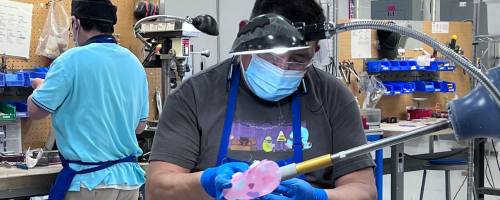
Training Within Industry, commonly referred to as TWI, originated in the United States in the 1940s during World War II. According to the TWI Institute, a national network of industry professionals was drafted to develop techniques to quickly train unskilled workers entering the war production workforce as many skilled laborers went to war.
TWI was introduced in Japan after the war for rebuilding purposes and is still widely used today, most notably as part of Toyota’s Production System. It has helped drive success for Toyota in continuous improvement, standard work, and its ability to sustain those improvements.
While its use in the U.S. faded over time, TWI has seen a resurgence in recent years as industries such as healthcare, construction, and manufacturing are reaping its benefits.
Training Within Industry helps manufacturers develop a skilled workforce.
This proven tool applies to anyone who teaches anybody to do anything. It’s ideally suited for supervisors, team leaders, and those indirectly managing others. A superior training methodology, particularly in a mass-production setting, TWI helps manufacturers facilitate more incredible market speed and removes waste associated with training time. Once taught, it helps sustain high performance and excellence in quality.
For manufacturing companies concerned about retiring employees taking their production and operational knowledge with them, TWI can help capture that experienced know-how and transfer it to the remaining workforce.
TWI teaches workers more than just what to do to complete a specific task; it reinforces how to do a job and gets them to understand why the job must be done that way.
TWI-JI
One of the first courses of Training Within Industry is Job Instruction (JI). TWI JI aims to get workers fully trained and add value to the organization in the shortest period possible while preventing problems that could arise from faulty instruction. JI establishes a single best method for doing a job and allows a trainer to transfer knowledge to a learner while verifying comprehension quickly.
TWI-JR
Another TWI program is Job Relations (JR) training. TWI JR training involves teaching supervisors how to handle problems and prevent them from occurring, and it helps develop a logical approach to tackling issues with a people-centric view. The core elements of JR teach the basics of consensus-building and individual problem-solving, leading to positive employee relations.
TWI-JM
Supervisors are under pressure to produce a greater quantity of higher-quality products in less time. Optimal use of resources – people, machines, and materials – can make this goal a reality. Job Methods (TWI JM) demonstrates how to accomplish this by breaking down jobs, questioning details, and developing new methods by eliminating, combining, and rearranging each processing element.
TWI-JS
TWI also offers Job Safety (JS) provides a framework for supervisors to engage employees in identifying potential hazards and eliminating them in conjunction with their training and knowledge of OSHA and EPA regulations. TWI JS stresses that the supervisor-employee relationship is pivotal in fostering a safe and environmentally responsible workplace.
Hear from manufacturers about how we helped their companies address the essential skills needed by the leaders in their companies. Transferring valuable knowledge from seasoned workers to younger and newer employees in an organization can ensure that a job is done correctly and consistently over time.
Contact us here if you'd like to learn more about this program.